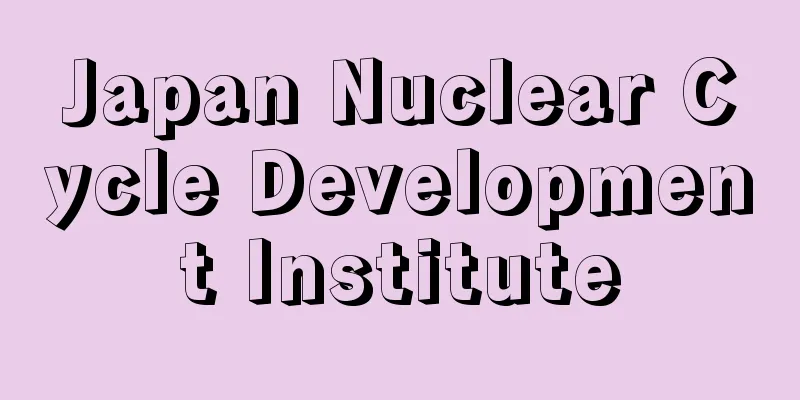Japan Nuclear Cycle Development Institute

|
A special legal entity established under Article 7 of the Atomic Energy Basic Act (Act No. 186 of 1955). Abbreviation: JNC. Predecessor to the current Japan Atomic Energy Agency. Article 1 of the Nuclear Fuel Cycle Development Institute Act (Act No. 62 of 1998) defined it as "established for the purpose of contributing to the promotion of the development and utilization of atomic energy by systematically and efficiently developing fast breeder reactors and the nuclear fuel materials required for them, reprocessing of nuclear fuel materials, and technology related to the treatment and disposal of high-level radioactive waste, solely for peaceful purposes, and by disseminating the results of such development." It was established in October 1998 to take over the business of the Power Reactor and Nuclear Fuel Development Corporation (DNC), which had been downsized. The first chairman was Yasumasa Togo. The head office is in Tokai Village, Ibaraki Prefecture. DoN lost public trust due to its inappropriate response to the sodium leak accident at the Monju fast breeder reactor in December 1995, and for distorting and concealing information about the accident. This prompted the governors of Fukui, Fukushima, and Niigata prefectures to make proposals on "how to proceed with future nuclear energy policy," and the government established the Atomic Energy Policy Roundtable within the Atomic Energy Commission to seek opinions from a wide range of fields in an attempt to form a new national consensus. In particular, there were calls to reconsider the development of fast breeder reactors, so the Fast Breeder Reactor Discussion Group (chaired by Junichi Nishizawa, former president of Tohoku University) was established under the Atomic Energy Commission, and 12 meetings were held. The conclusion was not very clear, but it was decided that "the construction of a demonstration reactor should not be rushed, but research and development of fast breeder reactors must continue." As the development of fast breeder reactors, the key element of the nuclear fuel cycle, became uncertain, the disposal of the excess plutonium that was accumulating became an issue. The Atomic Energy Commission decided on a policy to promote the so-called "plu-thermal plan," which involves burning plutonium in light water reactors. However, shortly after this, another fire and explosion occurred at Doen's reprocessing plant, and the company's response to that incident was also inappropriate, which led to a sense of public distrust in Doen's character. Due to the successive scandals, the former Science and Technology Agency established the "DoN Reform Review Committee" (chaired by former University of Tokyo president Yoshikawa Hiroyuki). During the committee's deliberations, a number of issues emerged, including "insufficient safety and crisis management," "closed nature," and "expansion of operations," all of which pointed to a "lack of management." As a way to improve the situation, it was decided to launch a "new corporation" to fundamentally review the operations and "dismantle and reorganize" the organization. A concrete proposal was considered in a working group, and a bill to establish the "new corporation" was submitted to the Diet in February 1998. It was passed in May of the same year, and the new corporation, the Nuclear Fuel Cycle Development Institute, was launched in October. The Japan Nuclear Cycle Development Institute established a management council to provide management opinions in response to inquiries from the president. The council was made up of 15 external academics and experts, and also sought to eliminate the "closed nature" that had been pointed out, such as by requesting an external evaluation committee to provide a professional evaluation of the operation plan. In addition, to clarify the company's emphasis on local areas, the headquarters was located in Tokai-mura, Ibaraki Prefecture, and the Tsuruga headquarters was located in Tsuruga City, Fukui Prefecture, where Monju was located. The Fugen Advanced Thermal Reactor, uranium enrichment operations, and overseas uranium exploration were designated as businesses to be streamlined and reduced, and were to be streamlined within five years. Fugen ceased operation in March 2003. However, there was insufficient time for the New Corporation Working Group to carry out a rigorous evaluation of the results of this national project, which had been carried out over 30 years and cost more than 2.3 trillion yen, and it seemed possible that a reconsideration would be necessary. Subsequently, in October 2005, the Nuclear Fuel Cycle Development Institute was merged with the Japan Atomic Energy Research Institute to establish the Japan Atomic Energy Agency, an independent administrative institution, as a comprehensive nuclear research and development institution. [Atsunosuke Nakajima] [References] | | | | |Source: Shogakukan Encyclopedia Nipponica About Encyclopedia Nipponica Information | Legend |
|
原子力基本法(昭和30年法律186号)第7条に基づいて設置された特殊法人組織。略称、JNC。現在の日本原子力研究開発機構の前身。核燃料サイクル開発機構法(平成10年法律62号)第1条では「平和の目的に限り、高速増殖炉及びこれに必要な核燃料物質の開発並びに核燃料物質の再処理並びに高レベル放射性廃棄物の処理及び処分に関する技術の開発を計画的かつ効率的に行うとともに、これらの成果の普及等を行い、もって原子力の開発及び利用の促進に寄与することを目的として設立されるものとする」と定義されていた。 1998年(平成10)10月、動力炉・核燃料開発事業団(動燃)が行っていた事業を縮小し、引き継ぐ形で発足した。初代理事長は都甲泰正(とごうやすまさ)。本社は茨城県東海村。 動燃は、1995年12月に起きた高速増殖原型炉「もんじゅ」のナトリウム漏れ事故に対する対応が適切ではなく、事故情報の歪曲(わいきょく)や秘匿などを行ったため、世論の信頼を失った。これを契機に福井、福島、新潟3県知事から「今後の原子力政策の進め方について」の提言がなされ、政府は原子力委員会に「原子力政策円卓会議」を設置、広く各方面の意見を求めることにより、新たな国民的合意の形成を図ろうとした。とくに開発見直し論もあった高速増殖炉は、原子力委員会の下、「高速増殖炉懇談会」が設けられ(座長・前東北大学総長西沢潤一)、12回の会議が開催された。その結果は、あまりわかりやすい結論ではなかったが、「実証炉の建設を急がないものの、高速増殖炉の研究開発は継続する事が必要」というものであった。 核燃料サイクルのかなめである高速増殖炉の開発が不透明になり、蓄積する過剰のプルトニウムの処理が問題となった。原子力委員会は軽水炉でプルトニウムを燃焼する、いわゆる「プル・サーマル計画」を推進する政策を決定した。しかし、その直後にふたたび動燃の再処理工場で火災、爆発事故が起こり、その対応においても適切さを欠いたため、動燃の体質に国民的不信感が醸成されるに至った。 相次ぐ不祥事により、旧科学技術庁に「動燃改革検討委員会」(座長・前東大総長吉川弘之)が設置された。委員会で行われた検討のなかで「安全確保と危機管理の不備」「閉鎖性」「事業の肥大化」など、「経営不在」という状況が集中的に現れた。改善法として、事業を抜本的に見直し、組織の「解体的再編」を行うために「新法人」を発足させるとした。具体案は作業部会で検討され、1998年2月「新法人」の設立に関する法案が国会に提出され、同年5月成立、10月から新法人「核燃料サイクル開発機構」が発足した。 核燃料サイクル開発機構には、理事長の諮問に応じて経営上の意見を述べる運営審議会が設けられた。これは、外部の学識経験者15名からなり、それ以外にも、外部評価委員会に業務計画の専門的評価を求めるなど、指摘された「閉鎖性」の解消に努めることとした。また、地元重視の姿勢を明らかにするため、本社を茨城県東海村に、「もんじゅ」のあった福井県敦賀(つるが)市には敦賀本部を置いた。なお、新型転換炉「ふげん」、ウラン濃縮事業、海外ウラン探鉱などは、整理縮小事業に指定され、5年をめどに整理を行うこととされた。「ふげん」は2003年3月運転を終了した。しかし、30余年にわたり2兆3000億円以上を費やして行われてきたナショナル・プロジェクトの成果の厳密な評価を新法人作業部会が行うには不十分な時間しかなく、再検討が必要となる可能性があると思われた。その後05年10月、核燃料サイクル開発機構は日本原子力研究所と統合し、原子力の総合的研究開発機関として独立行政法人日本原子力研究開発機構が設立された。 [中島篤之助] [参照項目] | | | | |出典 小学館 日本大百科全書(ニッポニカ)日本大百科全書(ニッポニカ)について 情報 | 凡例 |
<<: Nuclear fuel reprocessing plant (English spelling)
>>: Nuclear Fuel Safety Expert Review Committee
Recommend
Oil - oil
Oils are generally defined as substances that are...
American English - American English (English spelling)
In a broader sense, it refers to the English spoke...
Clerodendrum nutans (English spelling) Clerodendrum nutans
…[Kazuo Furusato]. … *Some of the terminology tha...
Dissociation degree - chelide
The fraction of dissociated molecules in the diss...
Echinococcus granulosus (English spelling)
...Also, if the gravid proglottid of the oocyte b...
Aasen, I. (English spelling) AasenI
...That is, the trend of national romanticism. It...
software
A collection of data that describes programs and i...
Naze [City] - Why
An old city occupying the northeastern part of Ama...
Seine fishing (trawl) - Hikiami
A net consisting of only a cone- or cylindrical-sh...
Chikura [town] - Chikura
An old town in Awa District facing the Pacific Oce...
prospective study
…(2) Cohort study: A cohort is a group of people,...
Business trust - Eigyo Shintaku
A commercial trust is a trust in which the trustee...
Tendenzfilm
...In what follows, I will discuss "tendency...
Robot - Robot (English spelling)
The word "robot" was coined in the 20th...
Appendage
An appendage, such as a leg, that protrudes from a...









